6.5. Interpreter Structure¶
Note
Re-visit 3.11 source code and correct details where different. Anything involving opcodes will have changed. A lot has changed to support concurrent interpreters.
Note
This section, although repeatedly re-written, still contains much thinking aloud. We learn from the moving target of CPython and its PEPs, while trying to theorise an alternative better suited to the JVM. There will be less rambling argument when we have made it work in practice.
6.5.1. Introduction¶
Importance for Jython¶
In Jython, support for multiple interpreters and threads is critical for certain uses.
An application may create more than one interpreter and multiple platform threads may use them. Jython has to provide clear semantics for multiple interpreters: initialisation, the scope of options, and the extent to which state is shared.
In a Java application server,
applications are separated by class loaders.
There may be multiple instantiations of
objects we normally think of as unique:
the Class objects themselves and fields declared static in them.
(A single class definition found by different class loaders
creates distinct Class objects.)
And yet, there is not complete isolation: loaders are hierarchical
and definitions found by the loaders towards the root
(basically, those from the Java system libraries)
create shared definitions.
Jython would not normally be one of these, but it could be.
Threads, platform threads owned by the application server itself, may visit the objects of multiple applications.
Jython has several times corrected its implementation of the life-cycle of interpreter structures, in the face of difficulties with threads and interpreters encountered in more complex cases. (These are not well supported by tests.) It is a source of bugs and confusion for users and maintainers alike.
Difficulty of following CPython¶
In CPython, support for multiple interpreters (sub-interpreters) has been present in the C API for a long time. Support for multiple threads is also well established, at least where the platform thread is created from CPython itself. The notion of a call-back, a platform thread entering the runtime from outside (a thread pool, say), is also supported, but here the C API is hedged with warnings that suggest this will not mix properly with the use of multiple interpreters. In spite of much helpful refactoring and re-writing between CPython 3.5 (when the present very slow project began), up to CPython 3.11 (current at the time of this writing), that warning remains necessary (see Sub-interpreters).
It seems there may be weaknesses here in just the place Jython needs to find a strong foundation. In that case, the architecture of CPython cannot simply be followed uncritically in a Java implementation. Nor, given experience, can we take it for granted that Jython 2.7 has it perfectly right.
As a prelude to implementing statements in sub-project rt1
(see Simple Statements and Assignment),
we attempted to get a proper structure for the interpreter:
the per-thread state,
the working state of the interpreter to which the threads belong,
and the relationship these things have to
platform-level threads (Thread in Java).
Also, we began to consider execution frames,
modules,
and ‘live’ objects,
implemented in Python then loosed into the wider application.
This continued to evolve in rt2 and now rt3.
This complex subject deserves an architectural section of its own, and here it is.
6.5.2. Runtime, Thread and Interpreter (CPython)¶
Critical Structures¶
CPython defines four structures, that Java would consider classes, in the vicinity of the core interpreter:
PyInterpreterStateholds state shared between threads, including the module list and built-in objects.PyThreadStateholds per-thread state, most notably the linked list of frames that forms the Python stack.PyFrameObjectis a Python object (typeframe) that provides the execution context for running aPyCode, the local variables and value stack.PyCodeObjectis an immutable Python object (typecode) holding compiled code (CPython byte code) and information that may be deduced statically from the source.
Additionally, _PyRuntimeState is a statically allocated singleton
that consolidates global data from across the CPython executable,
and holds the interpreters (of which one is the “main” interpreter).
An examination of the code allows us to draw the class diagram below. Not all the relationships are shown, but enough to support the discussion. Active development of CPython in support of multiple interpreters leads us to study CPython 3.11 in this section.
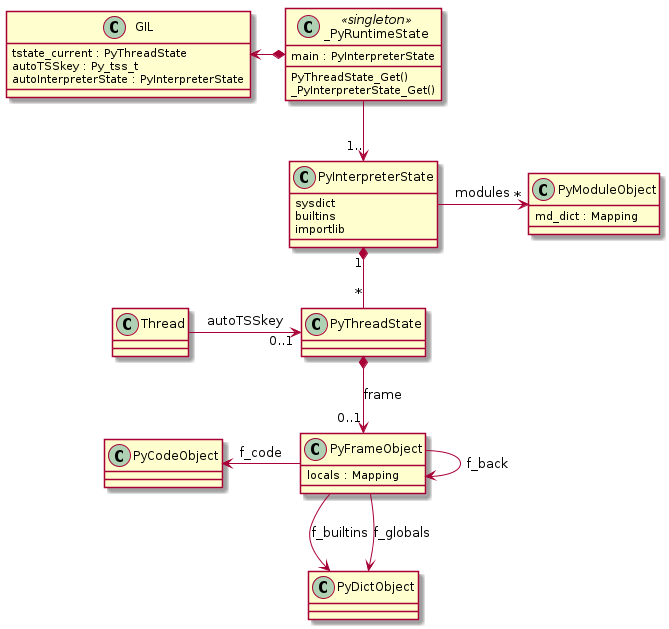
The Principal Runtime Structures in CPython 3.11¶
The choice of data structures in this part of CPython (and Jython) is shot through with the idea of multiple threads, and on exploring the CPython code, one quickly encounters Python’s Infamous GIL (Global Interpreter Lock). This is a feature we don’t want to reproduce in Java.
Python objects in CPython cannot safely be manipulated by two threads concurrently, and have no intrinsic protection against this being attempted. Authors often mention that reference counts need this protection, but they are not the only data at risk.
Instead of fine-grain locks on individual objects there is a global lock,
on the runtime as a whole (the GIL).
A thread takes the GIL by a call to PyGILState_Ensure(),
which installs its own thread state.
A thread relinquishes the GIL with PyGILState_Release(),
which allows another thread to handle Python objects.
A thread must take the GIL in order to handle Python objects safely.
The loop in ceval.c simulates concurrency
by creating an occasion to swap ownership of the GIL
between successive opcodes.
This makes the operation of most opcodes atomic,
all built-in functions implemented in C,
and the methods of built-in types implemented in C.
Thus, for all the apparatus there is in support of threads in CPython, the actual effect is to ensure only one of them can run at once. Very little hardware concurrency is possible in CPython.
A Python programmer may reliably assume that
even quite complex operations on built-in types,
for example set insertion or a list sort,
operates atomically without further safeguards.
The programmer may assume this when in fact
a definition in Python of __lt__ in the class of some list items
invalidates that assumption.
But a programmer using only CPython
will mostly get away with the assumption.
Jython 2 adapts some of the CPython apparatus in its own run time system to permit actual concurrency, but not without some bugs arising. We intend to support true Java concurrency in Jython 3 too, learning what we can from recent work in CPython 3.
Finding the right PyThreadState¶
The frame stack,
and all other state that should be used by a thread at a particular moment,
flow from identifying the correct thread state.
Each PyThreadState also points to the PyInterpreterState that owns it,
and so we have the correct module state for the code executing on the stack.
In places where the GIL is held,
CPython may use PyThreadState_Get() to find the current thread state.
This accesses the global _PyRuntime.gilstate.tstate_current
pointer to the current PyThreadState.
Similarly, _PyInterpreterState_Get() produces its answer
by first finding the current thread from the GIL.
When a platform thread does not hold the GIL these methods will not work,
and it cannot safely use Python objects.
A thread that does not hold the GIL
must call PyGILState_Ensure() to gain it.
CPython will first try to find a PyThreadState
from thread-local storage provided by the platform for this thread.
It uses a key chosen once and held in gilstate.autoTSSkey.
If there is no such storage on the current platform thread,
CPython creates a new PyThreadState
on the default PyInterpreterState gilstate.autoInterpreterState,
and associates this with the current platform thread.
This may happen, for example,
when a C library calls back into a CPython extension.
An artificial example is at temporary_c_thread()
in ~/Modules/_testcapimodule.c,
and several real ones are in ~/Modules/_sqlite/connection.c
in the CPython code base.
A PyThreadState created this way is distinguished such that
PyGILState_Release() will dispose of it,
rather than leave it associated with the platform thread.
Sub-interpreters¶
When it comes to threads, the CPython C-API is aware of its shortcomings, see Initialization Bugs and Caveats. Recent work to expose sub-interpreters at the Python level in PEP 554 has clarified the definition and use of these structures behind the scenes, as well as exposing an abstraction of them as part of the language. But it remains necessary to caution users against mixing sub-interpreters with the sort of manipulation of the GIL necessary to deal with Non-Python created threads.
The direction of development in this part of CPython is towards
one GIL per interpreter (in PyInterpreterState),
so that interpreters will truly be able to execute concurrently.
Some of our discussion of CPython anticipates this development,
in order to contrast it with a proposed Java approach.
Interpreters in CPython do not share objects unless those objects are immutable and effectively immortal (PEP 683): each interpreter manages the lifecycle of objects it allocates. (Draft PEP 684 leaves open whether interpreters have separate memory pools or use a common thread-safe allocator.) As a result, it is safe for threads in different interpreters to handle objects they encounter without further checks.
In fact, interpreters do not share objects by design, but CPython cannot prevent an application or extension from handing an object created in one interpreter to another interpreter. In the simplest case, a C application may create two interpreters, i1 and i2, get a result r (a Python object) from i1, and call a function in i2 with that as argument.
CPython relies on the careful construction of C extensions and applications
to avoid this.
A case is noted at the end of the section
Finding the right PyThreadState
where no amount of care seems enough.
When a thread enters extension code from the platform,
to be handled by an object belonging to i1
(for example in a call-back posted by i1),
that thread may not be associated in thread-local storage with i1.
It may belong to another interpreter i2
through an existing PyThreadState,
or be given a new PyThreadState in the default interpreter.
Whatever the origin, several problems now arise:
When i2 performs operations on r, the reference count of r or of a member might be updated in a race with a thread in i1. (The current thread only holds the lock in i2.)
Similarly, i2 may perform operations on r that lead to its destruction (reference count zero), or the destruction of a member (e.g. if i2 were to delete an item from a list in r). The memory would either be returned to the i2 allocator, which does not own it, or possibly to the i1 allocator unsafely, without holding the i1 GIL.
When code in i2 calls a method on r, it will execute code written in the expectation that the import context in which i1’s methods were defined, will apply when it runs.
Notice that the last of these is a question on the meaning of the Python language. The others seem to be issues specific to CPython memory management, whereas in Java, the JVM will take care of memory management.
Sub-interpreters for Concurrency¶
PEP 554 exposes the current C API (with its single GIL) for use from Python. It does not introduce a concurrency mechanism per se: that requires changes to the runtime. In the perception of many, however, the value of the PEP is in exposing for use an API that subsequently will support concurrency through sub-interpreters. This has now been formally proposed in draft PEP 684.
The proposal is to have one GIL (not global any more) per interpreter. It would serialise threads competing in a single interpreter, except in the special cases where the GIL is explicitly released. (as now e.g. during slow I/O).
Objects are confined to a single interpreter, at least if they are mutable (including the reference count). They are allocated from and returned to the memory pool of that interpreter. Threads are also confined to a single interpreter, and restricted to access only that interpreter’s objects. Since only one platform thread can run at a time in a given interpreter, thanks to the GIL, only one thread may be running in a given object.
This clever scheme achieves thread-safe concurrency without the cost of per-object locks or much extra record keeping at all. The down side is the constraint on the free sharing of objects: while many threads may visit an object, they must all be threads of the interpreter that owns that object.
How might the runtime structures change to accommodate concurrent interpreters? It is possible to speculate as follows:
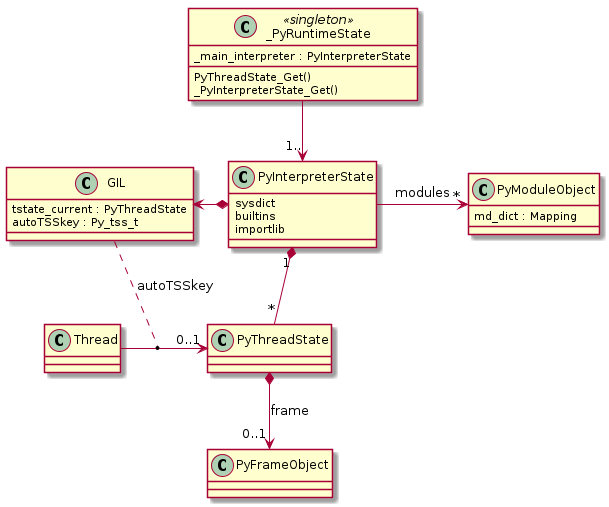
Conjecture: Structures in CPython with per-interpreter GIL¶
A platform thread could have a thread state
in each interpreter where it handles objects (we think),
since each GIL may hold a different autoTSSkey.
However, the problem remains that
a platform thread in need of a reference to its current thread state,
must find it in the GIL of the right interpreter.
Previously the interpreter was found through the thread state, using the universal GIL (see Finding the right PyThreadState). How does a platform thread first establish the current interpreter? It seems it would have to be the default interpreter as before.
A different approach in Jython?¶
A number of difficult cases may be devised involving threads and interpreters, where it is not clear from current documentation or code how CPython would deal with the circumstances. We must make this answer well-defined in Jython, despite the inherent multiplicity of objects.
In Jython the JVM manages the lifecycle of objects. It becomes unnecessary to tie objects to an owning interpreter since there is only one memory pool. We only need to know the current interpreter for its inherent state and certain context, such as the registry of imported modules and codecs. In return, we must be careful to make objects thread safe where CPython can already assume only one thread can be present.
We will propose a different approach for Jython from CPython, made possible because the JVM manages the lifecycle of objects. All the same behaviour should be expected of interpreters exposed to Python as in the C implementation.
6.5.3. Use cases¶
We will catalogue several patterns in which interpreters and threads might be used. The idea is to test our architectural ideas in theory first, in a series of use cases. We may then prove the implementation by constructing test cases around them. The first are somewhat trivial, for completeness only.
Using Python Directly¶
An application obtains an interpreter and gives it work to do. It may be called to run a script (Python file) or fed commands like a REPL. Objects the application obtains as return values, or from the namespace against which commands execute, will generally be Python objects, with behaviours defined in Python code.
The Jython 2 main program is a particular case, and we’ll need that or something similar in an implementation of Python 3.
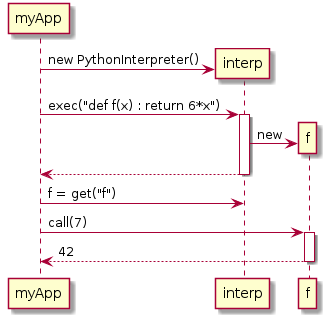
Using Python Directly¶
For simplicity we show get() acting on the interpreter.
Does a separate namespace dictionary better represent the source?
Considerations¶
Ensure invocation by a user application is trivially easy.
Contrary to this, is explicit initialisation of the runtime preferable?
Try to ensure well-known examples (Jython Book) still work.
The client may drop
interponce it has its result.Quite likely the Jython runtime core is static (global), and not disposed of when an interpreter might be.
The interpreter must exist as long as needed by the objects it created.
But sometimes a returned object is just a Java object (
42).
What is the context of an
importin the body off?
Using Python under JSR-223¶
As previously, an application obtains an interpreter and gives it work to do. Possibilities are mostly as in Using Python Directly, except that the usage is defined by JSR-223. The Java Scripting Programmer’s Guide gives examples of use, from which we take “Invoking a Script Function” as our example (but in Python, of course).
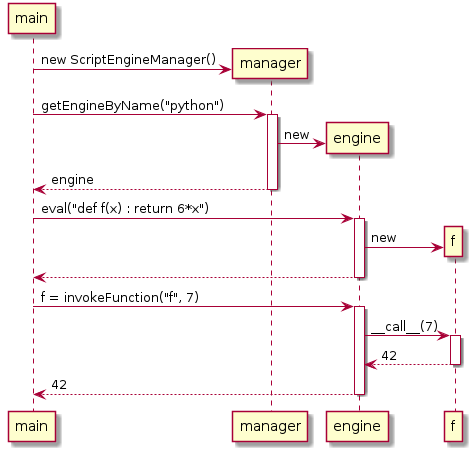
Invoking a script function under JSR-223¶
In this simple case,
we take a “hands off” approach to using the object f
in the name space of the interpreter,
referring to it only by its name.
Considerations¶
We only note those additional to Using Python Directly.
Invocation and API are as defined by JSR-223 and the JDK.
The
enginemay hold the interpreter as long as it exists.The Jython 2 interpretation is a little weird: let’s think again, especially that thing about thread-local globals.
Implementing a Java interface under JSR-223¶
The JSR-223 API is far richer than the previous example gives space for
(see Java Package javax.script).
In another example adapted from the Programmer’s Guide,
we handle an object directly that implements a specified interface.
Suppose that in a script r.py we define a class R like so:
from java.lang import Runnable
class R(Runnable):
def run(self):
print("run() called")
When we execute the script,
it defines a type R to Python with a descriptor for run()
and to Java a class that extends java.lang.Runnable.
Next we create an instance r in Python of that class
that is also an instance of R in Java.
Both R and r are stored in a name space not shown,
the globals of engine’s interpreter.
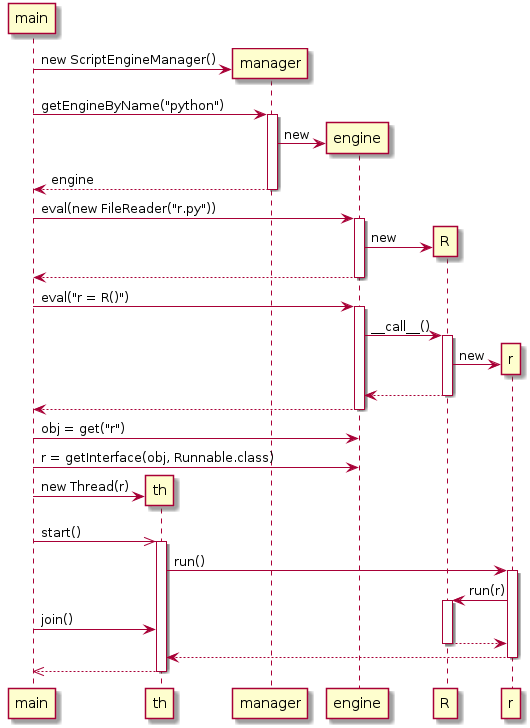
Implementing Runnable under JSR-223¶
Considerations¶
We only note those additional to Using Python under JSR-223.
Use in a
Threaddemands thatRextendRunnableand therefore dynamic Java class creation is part of Python class creation (with ASM).Some platforms may not allow that.
Perhaps only when a Java class is named as a base.
ris the same object in both Java and Python, but its Python typeRis not the same object asr’s class in Java (nominally alsoR).The Java method
r.run()must invoke PythonR.run(r)found as a descriptor by look-up on PythonR.maincould simply have castobjtoRunnable. The idiomr = engine.getInterface(obj, Runnable.class)allows theengineto proxy the actual object, which is not necessary with the “plain objects” design.maincould have created multiple threads passingr, resulting in concurrent look-ups and invocations ofrun().
Using Python Twice Directly¶
An application obtains two interpreters using the mechanisms in Using Python Directly, or by JSR-223. It takes an object defined in one interpreter and calls a method on it in the second. For variety, suppose the application shares the objects from the first interpreter by sharing a dictionary as the namespace of both.
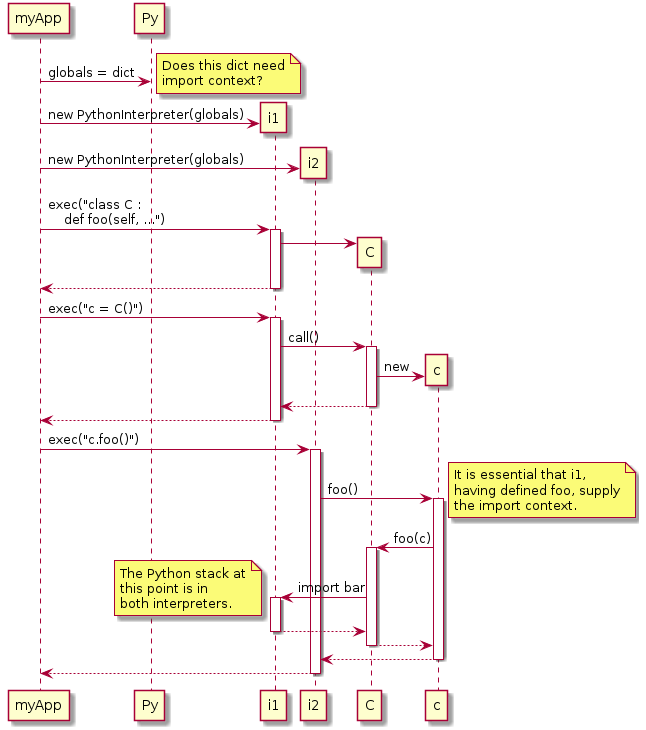
Using Python Twice Directly¶
Considerations¶
We only note those additional to Using Python Directly.
A single thread is valid in two interpreters simultaneously.
When
foois executing, called byi2, the current interpreter must bei1.A dictionary object is created before any interpreter. If a built-in is guaranteed not to need import context, does it have an interpreter at all? What if it needs a codec or
sys.stderr?If the (platform) thread has a thread state in each interpreter, there will be two (disconnected) stacks. One stack (i.e.
ThreadState) per thread seems logical, and so threads do not belong to interpreters.
Python behind the Library¶
A Java application uses a Java library.
The implementor of that library chose to use Python.
This is not visible in the API:
objects are handled through their Java API
but get their behaviour in a Python interpreter i1.
A second interpreter i2 is also in use by the application directly.
The application asks it to manipulate objects from the library,
whose implementation uses the first interpreter.
The Python implementation of the objects from the library
will not be apparent to the second Python interpreter.
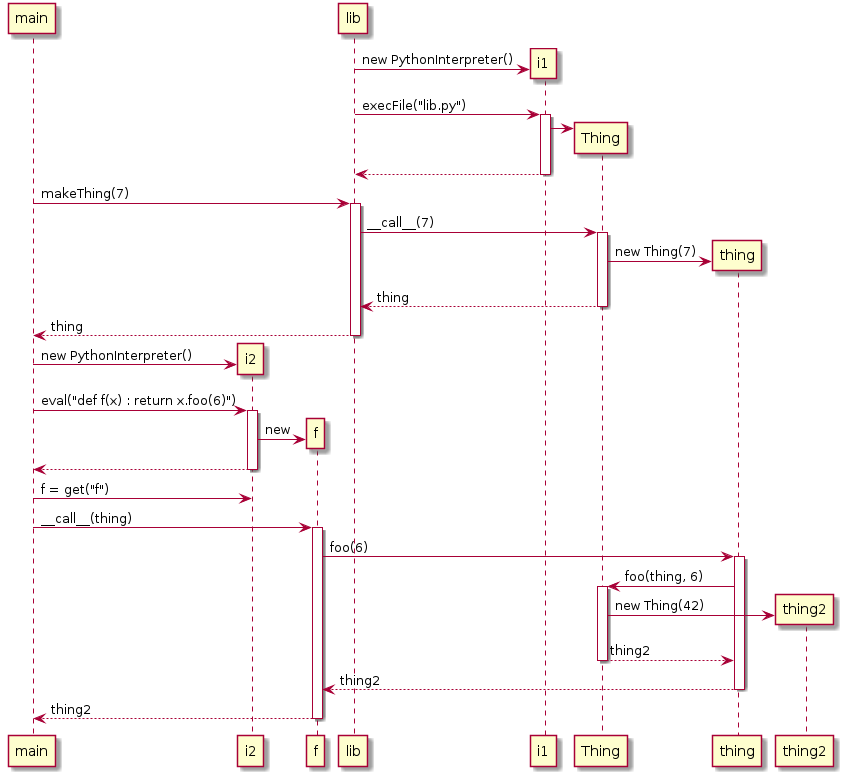
Python behind the Library¶
In the last section of this sequence,
main calls f passing the thing that the library created.
f is written in Python
so in order to call foo it is going to look up the name in
the Python type corresponding to the class of thing.
This is because we have assumed a single Python run time system,
where the single type registry exists,
because there is one static ClassValue for Python type.
We could allow the creation of multiple run-time systems,
but the Python types of exchanged objects
and Java types (like String) that both run-times handle.
give rise to duplicate types.
Considerations¶
A single thread is valid in two interpreters simultaneously.
The single run-time system is necessary to share Python objects.
The library does not hide the Python nature of its objects.
On resolving the Java class of
thingtoThingini2, we would be led to the Python typeThingcreated by the library underi1.A library could hide its Python objects by only handing out pure Java classes that use them, but two interpreters using one of those would share the type object.
Application Server¶
The user application runs in a Java application server (like Apache Tomcat) in which user applications are not processes but segregated by class loader, and threads are re-used.
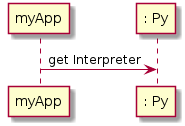
Application Server¶
Note
Not yet elaborated.
Considerations¶
Thread local data and class values created in one application may still present for other applications.
Class values attached to persistent classes are not disposed of.
Approaches designed to ensure objects are not retained (e.g. use of weak references) may result in discarding state when it is still wanted.
6.5.4. Proposed Model for Jython [untested]¶
In the Jython model, we propose a different arrangement of the critical data structures from CPython. In particular, we abandon the idea that a thread or an object belongs to a particular interpreter. Although possibly controversial, we expect to be able to address more challenging use cases than with the CPython model.
Critical Structures Revisited¶
We have implemented this model in the rt3 iteration evo1.
At the time of this writing,
we have not tested it with multiple threads and interpreters.
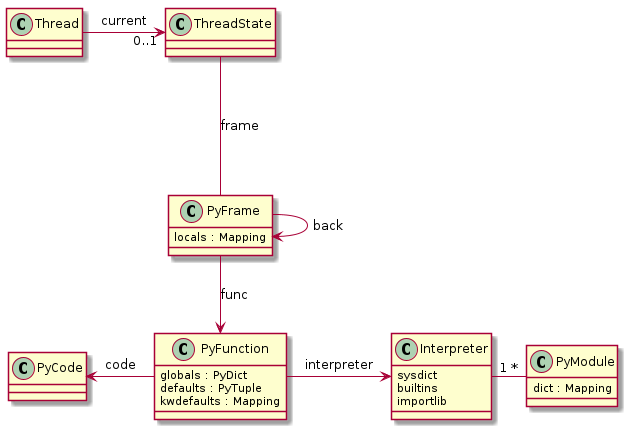
The notable differences from the CPython model are:
ThreadStateis not associated with a unique “owning”Interpreter. AThreadStateis associated with multipleInterpreters but only through the frames in its stack (if the stack is not empty).Each
PyFramereferences aPyFunction. (In fact, CPython does do this privately from version 3.11.)Each
PyFunctionreferences anInterpreter.Each
PyModulereferences anInterpreter.
We now identify some assumptions (hypotheses) that led to this model or are implications of it. These are ideas we might test as a way of testing the overall model.
Threads are freely concurrent¶
The hypothesis is effectively that we don’t need a GIL — a lock that must always be held in order to execute Python code. Instead, locks are taken in order to access individual objects safely.
In this model,
platform threads that handle Python objects
(and are associated with a ThreadState as necessary)
are freely concurrent with minimal constraints.
They are scheduled by the platform,
meaning the JVM or the operating system itself.
Threads may be physically concurrent if the hardware allows it.
Even where the hardware does not allow that,
the stream of instructions will be interleaved by the JVM or OS
which acts without regard to the state of Python.
This does not mean that threads will run entirely unconstrained. We will need (and the platform offers) locks of various kinds to constrain threads where we have to.
Python objects must be thread-safe individually¶
Python objects that may be visited concurrently by threads must be thread-safe. (They must continue to meet their specification in the face of potentially concurrent access.)
It is difficult to say for certain that any Python object could never be used concurrently, still less any built-in type as the type of an object is constantly consulted when running Python. Even a local variable in a function is in principle reachable concurrently via a closure or by examination of a frame. We conclude that every Python object must be made thread-safe.
Objects that are immutable are inherently thread-safe. Others must be made thread-safe by means of appropriate synchronisation.
Application code in Python has to pay attention to concurrency in its own right to protect the integrity of its composite structures. This is additional to the safety that our implementation supplies. A class will not be thread-safe simply because its members are thread-safe individually.
Objects in the run-time must be synchronised¶
Objects in the run-time system that may be visited concurrently by threads must also be thread-safe. We write this separately from the similar statement about Python objects as the strategies can be quite different.
Construction of an object is naturally thread-safe, since the object is not accessible until constructed. The same can be true of Java class initialisation if it is not too complex. (Reentrancy in a single thread is a hazard here too.) We make maximum use of immutability, so that objects once constructed are inherently safe.
Much of the time, data will be in Java local variables. Unlike in Python, these can be in the scope of only a single thread. For everything else, there are locks.
We aim to protect shared data by means of appropriate synchronisation. Particular cases may be recognised:
The type system.
The import system.
These are both places where Jython 2 makes careful use of locking.
Comparison with CPython’s GIL¶
There is a cost to synchronisation. The locking strategy of CPython is a conscious choice that allows the implementation to be written with little attention to concurrency, except at specific points “between byte codes”. There is only one lock (per interpreter) and the CPython core developers judge this to be more efficient than many fine-grain locks.
CPython’s approach to object lifecycle management is a factor in that calculation. It would be necessary to take and release locks constantly in order to protect reference counting object by object, or at least to use atomic variables for that, which also has a cost.
Java manages object lifecycle for us and so we do not need the same locks or atomic variables for that.
The hypotheses entailed by our approach¶
It is a hypothesis that what we gain by not having to manage lifecycle explicitly, exceeds the costs we incur in the fine-grain locks we do need. Java locking is understood to be cheap when not contended, e.g. when there is only one thread.
We also effectively advance the hypothesis that, where multiple threads are involved, we gain more from increased concurrency by letting them run, than we lose in managing multiple fine-grain locks.
Some objects have affinity with a single Interpreter¶
CPython gives the interpreter responsibility for a pool of memory, from which the objects are allocated that are handled in that interpreter. It allows one thread to run per interpreter, so that memory management is single-threaded in each pool.
This creates a strong affinity between every object and the interpreter that allocated it, and is the only interpreter that should handle it. The Python-level API for interpreters (PEP 554) provides no means to share most objects. The only exceptions are those objects that will never be de-allocated, and the channels that communicate between interpreters (for which special considerations apply).
No “lifecycle” affinity¶
We do not need the memory pool in our Interpreter,
where the JVM allocates and recycles all objects
(in its own dedicated thread).
Therefore we do not need this kind of affinity to an interpreter.
The hypothesis is that we can correctly
handle an object in multiple Interpreters.
Affinity to import context¶
The other main responsibility of the interpreter is for “import context”: the imported module list, import library, module path, certain short-cuts to built-ins (all to do with modules), and the codec registry (a similar idea).
When does import context matter to an object? In our use cases (for example Using Python Twice Directly), we found that we needed sometimes to be able to navigate from an executing method in a Python object to the import context for which it was written. This seems to be the only time running Java Python needs to know the interpreter. This is quite different from CPython where the memory pool of the interpreter is needed for:
the creation of any object, or
any action that drops a reference to an object.
A method definition in Python is a statement executed most often in a module or class body, but possibly in a nested scope. Execution of a module body occurs when it is imported into an interpreter, and it occurs once within each interpreter.
The programmer who manipulates sys.modules and sys.path,
or customises the import mechanism,
in the current interpreter before or after a definition,
surely intends to affect those definitions as they are executed
and for this interpreter to be current again while the method is executed.
This affinity is not a property of the thread that visits the method.
We do not find a reason for a thread (ThreadState)
to belong to an interpreter.
We hypothesise that the following object types do have an import affinity to an interpreter, immutably established when they are created:
A
framefrom the method or function whose execution creates it, or the interpreter that created it to execute the code (a module body or an immediate string).A method or function (or any callable?), from the interpreter that executed its definition.
Possibly a
modulefrom the interpreter that imported it.
Does a module need interpreter context after the body has executed, and outside a call to any function in it?
When a module is implemented in Python it seems enough that the functions defined by executing the body, and the methods of classes in it. should hold a reference to the interpreter, and for this to be added to the frame.
When a module is implemented in Java, the simplest way for every method to have such a reference is to add it as a field to the module instance.
Some methods may need the interpreter
e.g. builtins.exec needs it to create a frame
to execute its argument.
A frame references a particular interpreter [untested]¶
Any code that imports a module, must import it to a particular interpreter, so that it uses the correct import mechanism, paths and list of already imported modules, to which the module will be added.
Whenever we execute code compiled from Python,
we do so in a PyFrame (Python frame object).
We therefore hypothesise that a PyFrame
should keep a reference to the appropriate Interpreter,
so that we can always find it when it is needed as import context.
A PyFrame is ephemeral, so where does the information come from?
A frame may be the result of:
REPL, JSR-223 or explicit interpreter use.
Module import, when executing the module body.
The
execorevalfunction.Class definition, when executing the module body.
Function or method execution.
Lambda expression evaluation.
Generator expression evaluation.
The first four are actions in an interpreter that logically should provide
the import context for the frame that is formed.
The others seem to require that callable objects
should designate the interpreter that creates the instance
in the frame that results from a call.
We shall find that it is enough for the Python function object
to behave that way,
but that function objects arise in more circumstances
than might at first be expected.
This is further argued in A function designates its defining interpreter [untested].
A frame could find the correct interpreter indirectly.
We have chosen to follow a pattern suggested by
examination of CPython source in version 3.11.
Frames in that version have gained
a private reference to a PyFunctionObject.
It appears that this is never NULL,
being synthetic in the cases where no actual function is called
e.g when the frame is created to exec a code object or
load a module body.
A function designates its defining interpreter [untested]¶
Our hypothesis is that the interpreter current at the point of definition of a callable object is the one that should provide context for running its code. It must therefore be remembered as a property.
Where a function or method is defined in Python, we have argued this is necessary in order to preserve the import context prepared by an application programmer, in case we encounter an import operation. A reference to a module is not reason enough, since it will be resolved in the local or global variables.
The category of “callable” is wide. We now consider the possible kinds of callable in turn.
function defined in Python¶
The most straightforward way to produce a function
is the execution of a def statement.
In CPython 3.8 a definition produces this code:
>>> dis(compile("def fun(): pass", '<function-def>', 'exec'))
1 0 LOAD_CONST 0 (<code object fun at ...
2 LOAD_CONST 1 ('fun')
4 MAKE_FUNCTION 0
6 STORE_NAME 0 (fun)
8 LOAD_CONST 2 (None)
10 RETURN_VALUE
This creates an object into which is bound, amongst other things, a reference to the globals of the defining module, and if it is a nested definition, a closure referencing non-local variables.
In Java, the object is a PyFunction,
which when called and will produce a PyFrame
against which the compiled body (PyCode object) will execute.
This frame needs a reference to the defining interpreter
to give it the import context the programmer intended.
The PyFunction must therefore keep the reference.
lambda expression¶
A lambda expression results in the definition of a function object.
>>> dis(compile("fun = lambda i: i*i", '<lambda-def>', 'exec'))
1 0 LOAD_CONST 0 (<code object <lambda> at ...
2 LOAD_CONST 1 ('<lambda>')
4 MAKE_FUNCTION 0
6 STORE_NAME 0 (fun)
8 LOAD_CONST 2 (None)
10 RETURN_VALUE
There is no difference from regular function definition.
Generator expression¶
A generator expression results in the definition of a function object, which is then called once to initialise it.
>>> dis(compile("gen = (i*i for i in range(10))", '', 'exec'))
1 0 LOAD_CONST 0 (<code object <genexpr> at ...
2 LOAD_CONST 1 ('<genexpr>')
4 MAKE_FUNCTION 0
6 LOAD_NAME 0 (range)
8 LOAD_CONST 2 (10)
10 CALL_FUNCTION 1
12 GET_ITER
14 CALL_FUNCTION 1
16 STORE_NAME 1 (gen)
18 LOAD_CONST 3 (None)
20 RETURN_VALUE
The code object has generator nature,
but at run-time when we encounter MAKE_FUNCTION,
we shall hardly be able to tell it from a regular function definition.
Method of a class¶
Suppose we define a class in Python with one method.
The class definition is an executable statement,
where the class body is also executed immediately.
The method definition is then a function definition within that body:
>>> classdef = \
"""
class C:
def fun(self, a):
return a+1
"""
>>> dis(compile(classdef, '<class-def>', 'exec'))
2 0 LOAD_BUILD_CLASS
2 LOAD_CONST 0 (<code object C at ...
4 LOAD_CONST 1 ('C')
6 MAKE_FUNCTION 0
8 LOAD_CONST 1 ('C')
10 CALL_FUNCTION 2
12 STORE_NAME 0 (C)
14 LOAD_CONST 2 (None)
16 RETURN_VALUE
Disassembly of <code object C at ...
2 0 LOAD_NAME 0 (__name__)
2 STORE_NAME 1 (__module__)
4 LOAD_CONST 0 ('C')
6 STORE_NAME 2 (__qualname__)
3 8 LOAD_CONST 1 (<code object fun at ...
10 LOAD_CONST 2 ('C.fun')
12 MAKE_FUNCTION 0
14 STORE_NAME 3 (fun)
16 LOAD_CONST 3 (None)
18 RETURN_VALUE
Here CPython 3.8 has created an ephemeral function C() and
passed it to a special __build_class__ built-in function.
(A reference to that is what LOAD_BUILD_CLASS leaves on the stack.)
The code object for the ephemeral function is
the body of the class definition.
__build_class__ executes that body function
against a dictionary that captures the definitions made.
Both functions should follow the rule that
the interpreter that executes the definition should be
the interpreter that executes the body.
Then wherever this type is used
(in whatever interpreter)
the defining interpreter provides context during C.fun.
This is also true of implementations that could possibly be given for
__init__ or __new__,
even though a statement that creates an instance of C
is executed in the context of a different interpreter.
If a sub-class of C were to be defined with further methods,
in a second interpreter,
the added methods would have affinity with the second interpreter,
while the ones inherited unchanged would keep their original affinity.
Instance with __call__¶
Suppose we define a class with __call__,
that is, we define a custom callable.
>>> class C:
def __init__(self, n):
self.n = n
def __call__(self, x):
return x * self.n
>>> triple = C(3)
>>> triple('A')
'AAA'
It should be apparent by now that the defining interpreter of the class
is the current interpreter during __new__, __init__ and __call__,
and for the good reason that their text was authored in that context.
This is why we make the statement we do only about function.
It does not matter in what interpreter the instance of C is created.
If in a second interpreter we create a new C and call it,
the call runs entirely in the first interpreter
where C.__call__ was defined.
>>> double = C(2)
>>> double(10)
20
In fact,
the context of the second interpreter can easily have its effect
if C.__call__ can be made to execute a function
defined by the second interpreter.
It could be that C allows customisation of the meaning of __call__
through a parameter to __init__,
or it could be that the call itself introduces the local context like this:
>>> class X(int):
def __mul__(self, n):
return (self+1)*n
>>> double = C(2)
>>> double(X(10))
22
We conclude that it is the def and class keywords,
and equivalent constructs recognised by the compiler
(all resulting in a MAKE_FUNCTION opcode in the cases exhibited),
that impress the current interpreter onto a callable,
which is always a function.
A function defined in Java¶
A function defined in Python has affinity with the interpreter that defined it: what is the affinity of a function or method defined in Java?
Most methods (in Python or Java)
will not in practice be sensitive to the import context.
Calling a Java method (in a built-in type or extension module)
does not itself create a Python frame.
However, the method could invoke the import mechanism,
create a PyFrame directly,
or call a function implemented in Python,
and then we would have to know which interpreter was involved.
The API for creating a PyFrame or for importing a module
could reasonably demand the interpreter be explicit
in the call signatures.
If the interpreter is not explicit, it could be found from the top frame of the Python stack, which in turn is found from the current thread. When the stack is empty, perhaps what is being attempted is meaningless anyway, and an error should be signalled at the point the interpreter context is needed.
A PyModule designates its defining interpreter [dubious]¶
The body of a module defined in Python is sensitive to the import context like any other code. This context is defined by the interpreter into which it is being imported, and stamps itself on the functions and classes the module defines.
It is not clear that the module needs to retain this affinity itself, except through the callables it leaves behind.
A Thread always has a ThreadState [dubious]¶
From within any platform thread (java.lang.Thread),
according to our model,
we may navigate to the corresponding ThreadState.
We expect to implement this as a thread-local variable in the runtime.
(We’d say “global” here,
were it not for the possibility of creating instances of the “global” runtime,
under different class loaders.)
If the stack of a ThreadState is not empty,
the Interpreter designated by the top frame
(through its function)
may be thought of as the current interpreter.
If the stack is empty, arguably no interpreter is current.
Contrary to the hypothesis,
there is no guarantee at all that an arbitrary platform thread
has been assigned a ThreadState by the Python run-time system.
However,
at the point we need it,
the run-time system will find or make a ThreadState.
This is a standard pattern with a ThreadLocal.
Consider the case where a Java thread pool
is responsible for call-backs into objects defined in Python.
Threads are chosen arbitrarily by the pool:
the history of that thread’s interaction with Python
should not affect subsequent behaviour.
Any ThreadLocal value retained from last use can only be misleading.
This suggests that the incoming pool thread
should begin with default state in all respects,
including an empty stack.
If the ThreadState is not actually destroyed on thread exit,
it should at least be zeroed.
The called object defines the interpreter, of course,
not the ThreadState.
Threads are not confined to a single Interpreter¶
CPython confines each thread to one interpreter as part of its scheme for ensuring that no two threads execute a critical section of C concurrently on the same data. Threads take turns to hold the GIL for their interpreter and only access the objects it controls exclusively. Global data are scrupulously avoided or guarded specifically.
Whatever the implementation language of the interpreter,
threads may enter critical sections defined in Python concurrently.
The objects they potentially contend for must be protected by
locks requested by the programmer
and found in the threading module.
In CPython the objects will belong to the same interpreter as the threads,
but this does not protect them from disorderly (pseudo-concurrent) access
from Python in the general case.
In our model, threads may cross easily between objects where different interpreters set the execution context. There is no exclusive ownership of objects by interpreters, and no global mechanism is constantly present at “opcode” level (GIL).
As objects are not confined to an interpreter,
we find no reason for a thread (ThreadState)
to belong to a fixed single interpreter,
as noted in Affinity to import context.
Objects instead must be associated with locks that de-conflict access, specific to the circumstances. This is the case whether the critical section of code is Python written by a user, in Java in an extension module. or in a single operation of the interpreter itself. These locks will operate without reference to a current interpreter.
Certain built-in types must be thread-safe [open]¶
We have discussed at length that we choose not to reproduce the CPython GIL, and that threads by default may reach any code or data concurrently. The absence of a global lock operative during every opcode means that built-in and extension objects in the Java implementation may have to protect themselves from concurrent access where their CPython counterparts make no explicit provision.
The different model presents the risk that users may write Python objects
that do not use the resources of the threading module
but rely on the atomicity of operations on built-in types
that is a consequence of the GIL in CPython and does not exist for us.
It is not clear what the policy should be in a Java implementation of Python, when threads are mis-handled by the programmer:
As much like CPython as possible.
Incorrect result possible, but with a Python exception (if detected).
May produce Java stack dump, but interpreter remains stable.
No guarantee even that the interpreter remains viable.
Nor can we always blame the programmer.
In Implementing a Java interface under JSR-223
we detected a need for method lookup (in a Python dict probably)
to be thread-safe in the face of multiple platform threads.
This chapter has been about the interpreter structure, which is heavily influenced by our needs when supporting concurrency. However, the subject is large enough to deserve separate treatment.